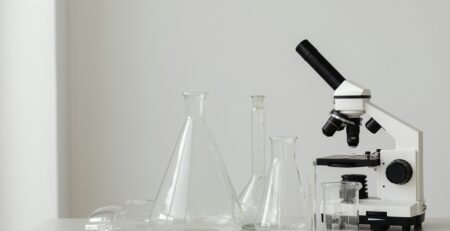1
Sep
Amber Glass vs Clear Glass: When to Use Each in the Laboratory
Laboratory storage is more than convenience — the choice between amber glass and clear glass can determine whether your samples remain stable, accurate, and compliant. From reagent bottles to iodine flasks, understanding when to use each type is critical for Australian schools, research, and industry labs.
Why the Colour of Glass Matters
Glassware colour directly affects how samples respond to light exposure. Clear glass allows maximum visibility, making it ideal for routine observation. Amber glass, on the other hand, blocks harmful wavelengths (particularly UV and blue light) that can degrade light-sensitive chemicals such as silver salts, iodine solutions, and pharmaceuticals.
By choosing the correct option, laboratories reduce waste, preserve sample integrity, and comply with safety standards.
Amber vs Clear Glass Comparison
| Feature | Amber Glass | Clear Glass |
|---|---|---|
| Light Protection | Blocks UV and blue light, prevents degradation | Full light transmission |
| Visibility | Limited view of contents | Maximum visibility of samples |
| Best For | Light-sensitive chemicals, pharmaceuticals, microbiology media | General lab use, teaching, and mixing |
| Common Products | Amber reagent bottles, iodine flasks, media bottles | Beakers, measuring cylinders, general flasks |
| Cost | Slightly higher due to colouring process | Lower, standard option |
Choosing the Right Glass for Your Lab
- Amber Glass: Essential when working with light-sensitive materials. For example, an Australian pharmaceutical QC lab stores its antibiotic solutions in amber reagent bottles to prevent potency loss.
- Clear Glass: Best for teaching labs, schools, and general research where visibility outweighs light protection. A Sydney high school chemistry lab uses clear beakers and cylinders for student safety and ease of measurement.
LabChoice BORO 3.3 Advantage
All LabChoice amber and clear glassware is manufactured from BORO 3.3 borosilicate glass, meeting ISO 3585 standards for durability and resistance to thermal shock. Whether for routine classroom experiments or high-compliance pharmaceutical storage, LabChoice Australia ensures both amber and clear options maintain quality, reliability, and long service life.
FAQs
Do amber bottles completely block UV light?
They significantly reduce UV and blue light but should be stored away from direct sunlight for maximum protection.
Are amber bottles more fragile than clear bottles?
No, both types are made from the same BORO 3.3 material and offer equal durability.
Can amber bottles be autoclaved?
Yes, LabChoice BORO 3.3 amber bottles can withstand repeated autoclave cycles.
Is clear glass acceptable for pharmaceuticals?
Only for non-light-sensitive compounds; otherwise, amber is recommended to maintain stability.
📚 References
Standards & Specifications
- ISO 3585:1998 – Borosilicate glass 3.3 — Properties. International Organization for Standardization.
https://www.iso.org/standard/26264.html - ISO 4796-1:2016 – Laboratory glassware — Bottles — Part 1: Screw-neck bottles. International Organization for Standardization.
https://www.iso.org/standard/65550.html - ISO 4796-2:2016 – Laboratory glassware — Bottles — Part 2: Narrow-neck bottles. International Organization for Standardization.
https://www.iso.org/standard/65551.html - ASTM E438-20 – Standard Specification for Glasses in Laboratory Apparatus. ASTM International.
https://www.astm.org/e0438-20.html
Academic & Safety Guides
Pharmacopeia (USP 41–NF 36) – General Chapter <671> Containers — Performance Testing (requirements for light transmission in pharmaceutical packaging).
https://www.uspnf.com
American Chemical Society (ACS) – Safe Storage of Chemicals: Choosing Amber vs Clear Glass. ACS Laboratory Safety Resources.
https://www.acs.org/safety
CSIRO – Laboratory Glassware Guide – Best Practices for Storage of Light-Sensitive Compounds. CSIRO, Australia.
https://www.csiro.au
University of Sydney – School of Chemistry – Teaching Manual: Use of Amber vs Clear Bottles for Chemical Storage. Sydney, Australia.

